Birds do what they have to do in order to survive in harsh conditions.
I published several of these photos long ago but I’ve long been unhappy with that post because of the way I’d processed the images and because I could/should have included more photos to better document and explain this fascinating behavior.
So yesterday I spent far more time than I wanted to attempting to retrieve those photos from an old, clunky computer on its last legs. Eventually I succeeded so today’s post includes five or six photos that are new to my blog. Image quality is mediocre because the photos were taken in harsh light so I had to heavily process them in order to manage the extreme contrast as best I could.
For any who may be disturbed by the crassness of my title, feel free to substitute “mucus” for the offending word.
Before Europeans came to North America and modified the environment into the agricultural and suburban landscapes of today, the range of the Brown-headed Cowbird was limited to the short-grass plains where they followed the almost endless herds of American Bison as they fed on the insects stirred up by those wandering behemoths. Early settlers so strongly associated cowbirds with bison that they almost exclusively called them “buffalo birds”.
Today that relationship continues to exist wherever bison can still be found and Antelope Island is one of those places.
One of the many challenges facing cowbirds was obtaining sufficient moisture as they followed the bison herds over the hot, rolling plains. On a hot morning in late summer of 2008 I documented a cowbird behavior that illustrated one of their strategies for dealing with that problem.
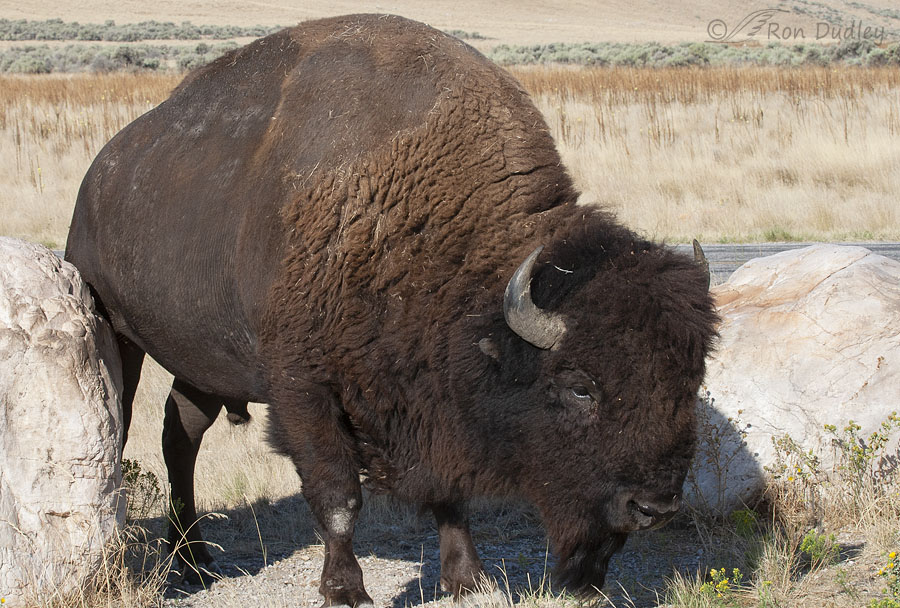
I found this huge bison bull languishing in the broiling sun next to a boulder that he’d been using as a scratching post. Here he’s scratching his right hip on the boulder at lower left. I knew I was too close to the bison to get all of him comfortably in frame but I took a few photos anyway.
There were some Brown-headed Cowbirds nearby but at first I wasn’t paying much attention to them.
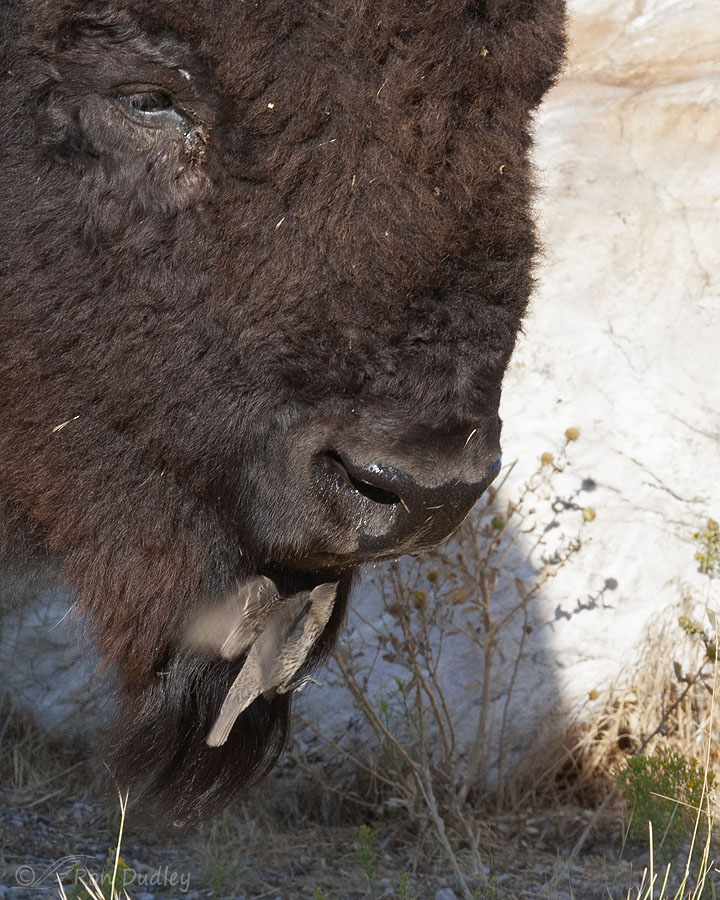
Then this female cowbird flew in and attempted to hover near the bison’s nose.
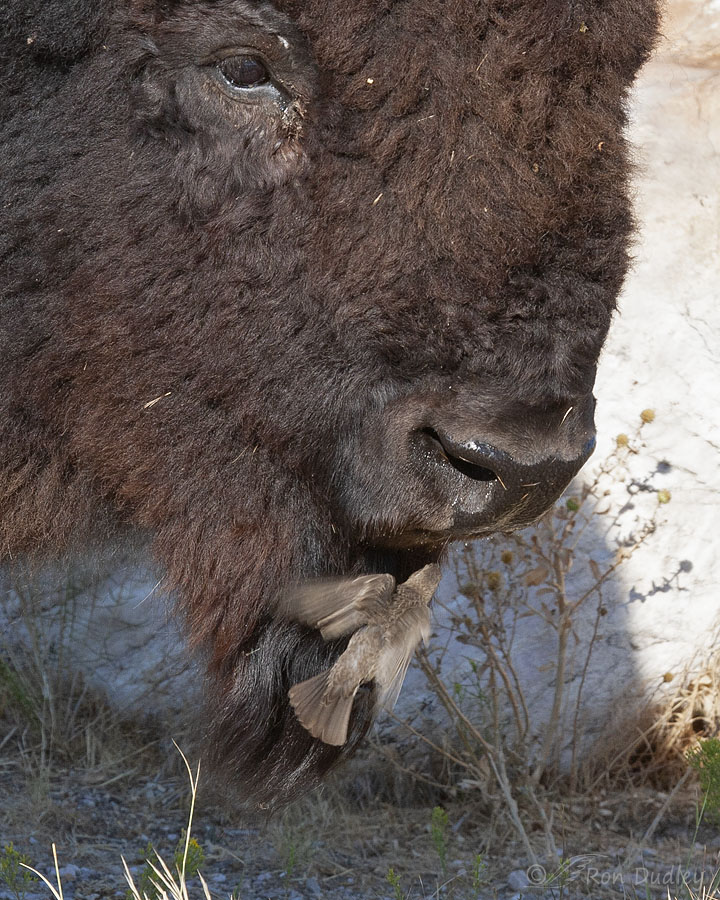
Hovering isn’t a highly developed skill in cowbirds so it was difficult for her, but she persisted. While I was in the field I had no idea what she was doing because it was all happening too fast and I was concentrating more on attempting to get my shots as sharp as possible than I was on trying to figure out what was going on.
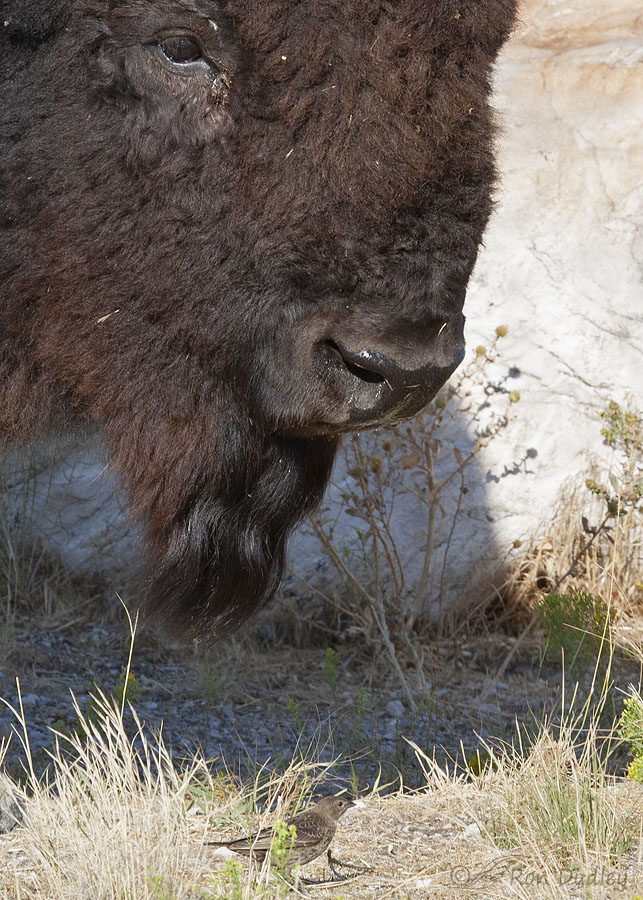
She’d hover near his nose for a few moments and then rest on the ground below his massive head. Hovering is hard work. This behavioral pattern was…
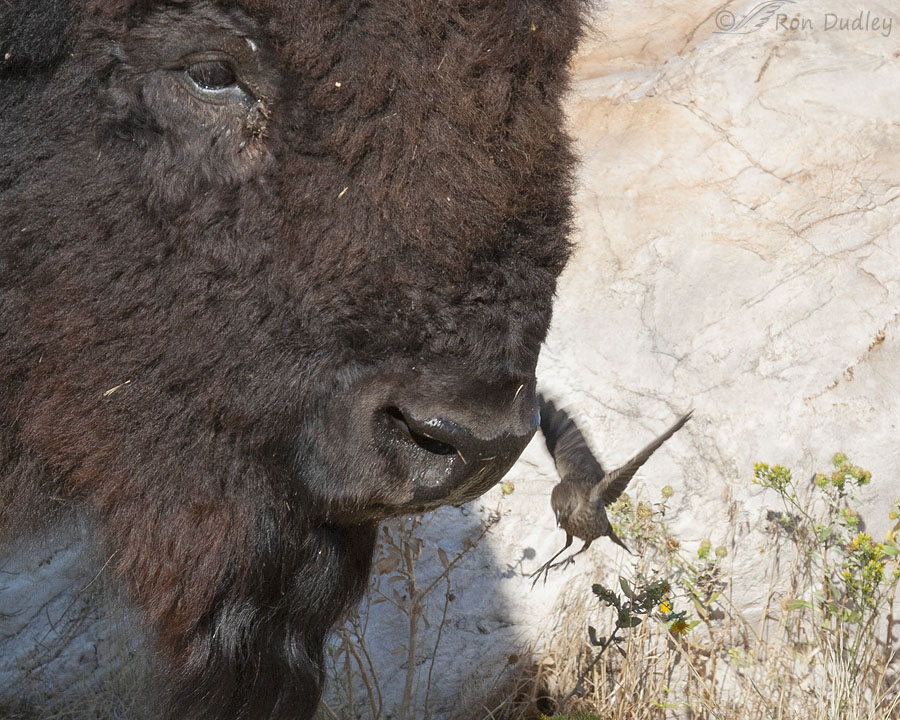
repeated…
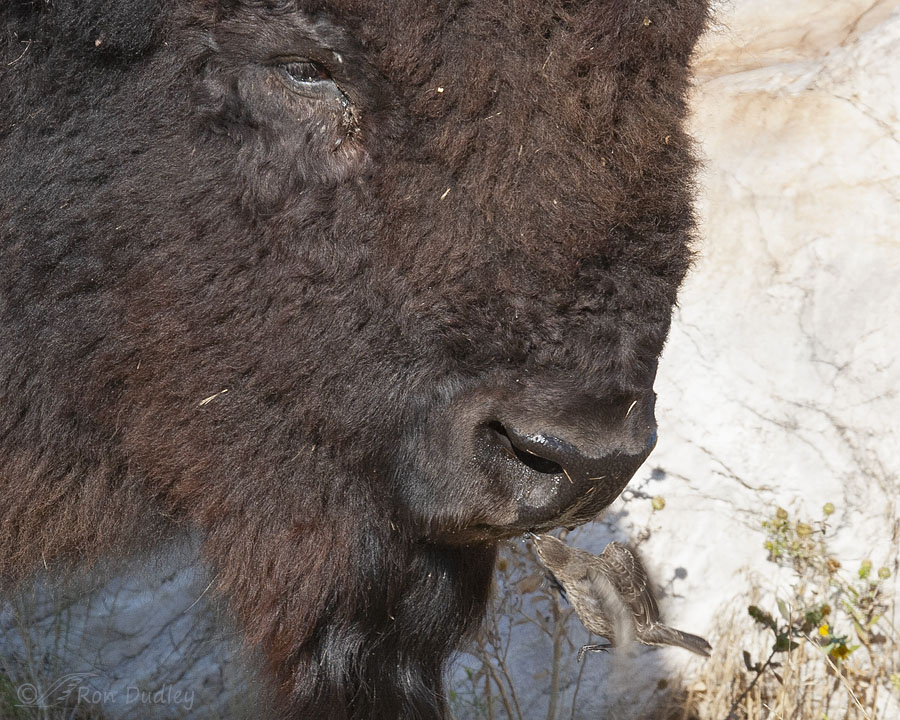
time and time again.
It wasn’t until I got home and looked at my photos on the big screen that I confirmed what she was doing.
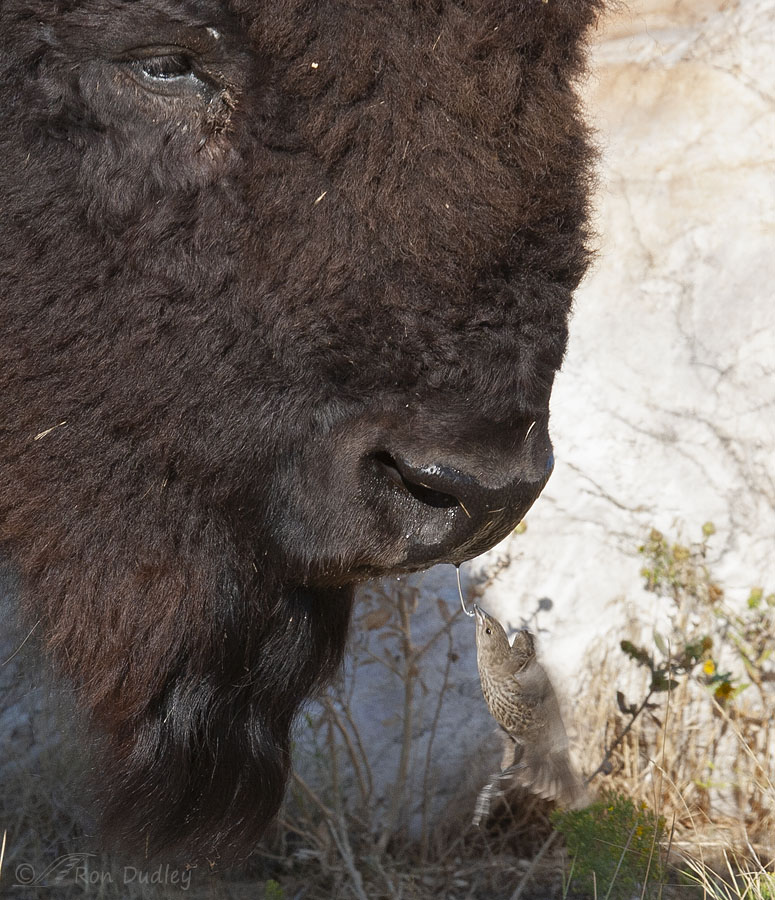
She was drinking watery, mucus-laden secretions that were clinging to and dripping from the bison’s nose. Here she’s slurping up a gobby string of it as she’s hovering.
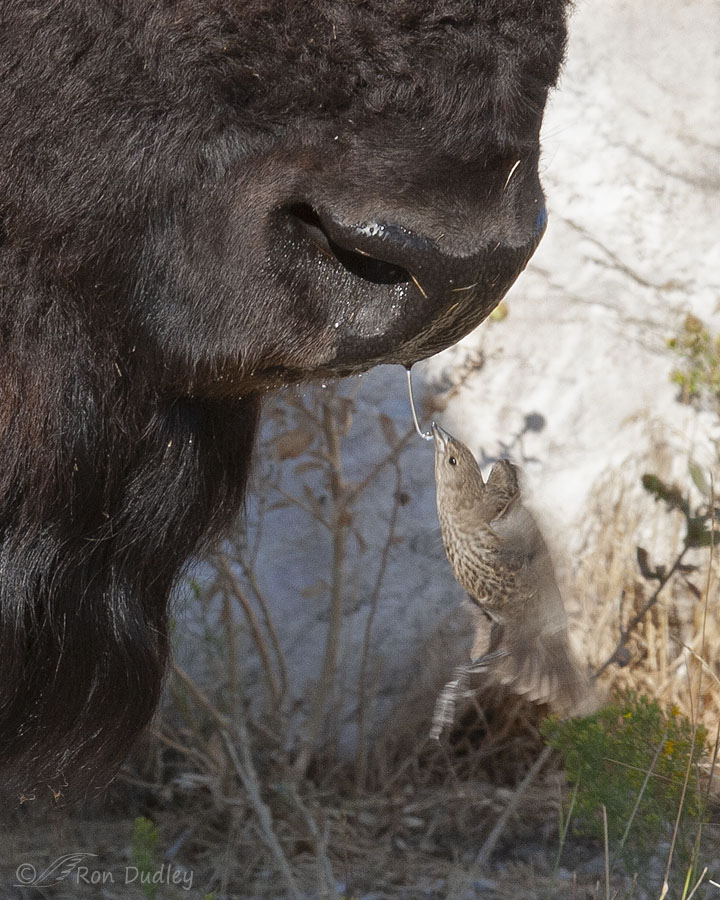
A closer crop of the previous photo reveals a little more detail.
This is a behavior that I’d never seen before and I haven’t seen, or at least noticed, since. But I suspect it happens far more often than I’m aware of. To human sensibilities it may seem like a gross behavior but when times are tough, birds do what they have to do to survive. As far as I’m concerned, more power to them.
Apologies if you were eating breakfast while reading this post.
Ron


The behaviors you capture and share are priceless information. They also encourage me to spend time looking at what the birds are doing while I’m out birding. Sometimes Birds of the World confirms my observations when other good birders have never noticed them.
You’re the most interesting science teacher I’ve ever had. THANKS!
Just have to smile at the photos you showed today. You got some good stuff so to speak!!
I have watched cowbirds do this with cattle in dry areas. Also the magpies will pick at the wounds the bison get on their backs from scratching the bitting flies in summer.
Yup.
Fascinating!! I love to wonder how these unusual behaviors evolved. Did the bison ever try to get him away?
No, Catherine. The bison completely ignored her.
Fascinating. Does our world still have such wimpy snowflakes? Don’t apologize, Ron, just say it like it is. Do you think the birds get any salt that way, as well?
“Do you think the birds get any salt that way, as well?”
I do, Sallie. Other minerals too. Even some calories but I’m pretty sure that water is what they were after.
Wow Ron, I almost gagged at the title. Just kidding – it is just nature being nature. Brown-headed Cowbirds are among my 10 most ignored birds. I have taken photos of them, but mostly ignore them although they are actually more handsome than we sometimes think. The funniest thing about their parasitic females though is watching one of their hatchlings growing up in a Warbler’s nest.
Good lessons as are most all of your posts covering biology as well as the history of the American Bison.
Thanks for posting.
Everett. I’ve seen Savannah Sparrows feeding cowbird chicks that were more than twice as big as the sparrows were. Photographed them too.
Haha! Love it… so interesting. And I was well done with breakfast – thank you!
Good timing, Joanne…
That is fascinating behavior ! If folks are “grossed out” by this one,
I’ll offer the one of butterflies “puddling” around mammals’ urine pools in search of the minerals they can obtain from them–slurp !
Kris, I’ve never seen butterflies doing that but I’ve heard about it. Slurp indeed.
These are fascinating! Now I won’t feel so bad if I’m delayed changing out the bird water dish each morning! Almost as interesting are the details of the bison’s head – that big nose, those tiny eyes! They seem way too small for that giant animal. And too bad Ms. Cowbird can’t do some cleanup around those eyes, too. Thanks for salvaging these from your old computer!
Thanks, Carolyn.
Just finished breakfast soooooo It IS interesting what lengths the birds and other critters will go to acquiring needed nutrients!
It IS interesting what lengths the birds and other critters will go to acquiring needed nutrients!
We have a leucistic Grey Crowned Rosy Finch in the “crowd” this morning! BOY, does it stick out like a sore thumb! Flocks have merged some so there are over 100 birds vying for the sunflower seeds – amazing if any will get more than 1 – except, of course, for those that are less spooky and don’t fly every few seconds…..
Judy, I sure wish I was there to get photos of that leucistic finch!
Tough sledding behind a chain link fence and MANY spooky birds tho I’m sure you’d have figured it out!
Wow! What an interesting and fortunate behavior capture. Persistence paid off for both you and the cowbird.
Thank you, Brett.
We have a large herd of bison out at the Rocky Mountain Arsenal Federal Wildlife Refuge out by Denver International Airport. I will have to keep a close eye on the interaction of birds and bison. I have seen Magpies foraging off the backs of these magnificent creatures.
Mark, magpies and cowbirds are the birds I see most often perching on bison. Starlings and blackbirds do it occasionally too.
gulp! WoW…. that is “interesting” Thanks for sharing.
Don’t “gulp” too hard, CJ…
LOL LOL LOL…. Only my Morning Coffee.
LOL
CJ